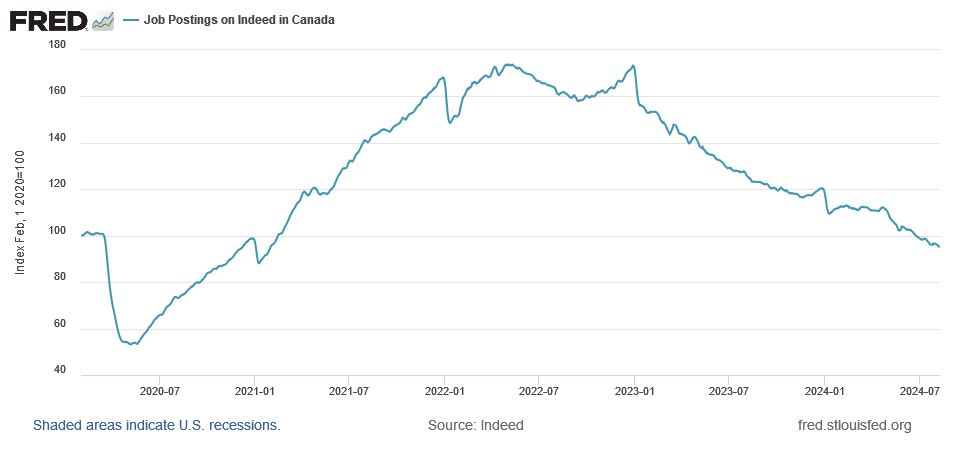Canada’s consumer price index (CPI) rose by 2.5% year over year (Y-o-Y) in July, a drop from the 2.7% Y-o-Y recorded in June, and the slowest annual increase since March 2021. Statistics Canada (StatsCan) published the data at 8:30 a.m. ET on August 20, 2024, via The Daily report. On a monthly basis, the CPI rose by 0.4% in July, well ahead of June’s 0.1% decline.
The data largely aligned with expectations, as the CPI results came in at or near economists’ consensus estimates. For example, the table below is courtesy of Investing.com. The left column represents July’s figures, while the right column represents forecasters’ expectations. As you can see, only the median CPI (marked in red) was lower than expected, while most of the figures (marked in black) met expectations. As a result, the current trajectory should convince the Bank of Canada (BoC) that its price stability efforts are working.
After cutting interest rates on Jul. 24, BoC Governor Tiff Macklem said that “monetary policy is working to ease broad price pressures,” and the risk of higher inflation “has to be increasingly balanced against the risk that the economy and inflation could be weaker than expected.”
He added, “If inflation continues to ease broadly in line with our forecast, it is reasonable to expect further cuts in our policy interest rate. The timing will depend on how we see these opposing forces playing out.”
In a nutshell: with the Canadian labour market slowing, the BoC can place less emphasis on fighting inflation and be more mindful of economic challenges.
In July 2024, the rise in month-over-month headline inflation was supported by higher gasoline prices, which rose by 2.4%. Likewise, travel tours (+4.5%), air transportation (+8.4%), and traveller accommodation (+7.1%) prices also contributed to the monthly increase.
Core CPI Slows in July 2024
Core measures of the CPI in July 2024 continued their downtrends, with the CPI-common index falling to +2.2% (from +2.3%), the CPI-median falling to +2.4% (from +2.6%), and the CPI-trim dropping to +2.7% (from +2.8%). These measures exclude the impacts of food and energy, and the BoC places heavy emphasis on core measures because they provide a smoothed distribution of overall inflation.
Please note that food and energy prices are highly volatile and price spikes can occur for reasons outside of the BoC’s control. In contrast, core inflation is largely driven by consumer demand and gives the BoC a better sense of how the Canadian economy is functioning.
Inflation Slows Across 6 of 8 Major Sectors
On a Y-o-Y basis, weaker readings occurred across six of the eight prominent categories. These include food, shelter, household operations, furnishings and equipment, clothing and footwear, transportation, health and personal care items, recreation and education expenses, and alcohol and tobacco products.
Clothing and household products continued their deflationary trends, while recreation, education, and reading prices also dipped into negative Y-o-Y territory.
Grocery Inflation Remains Troublesome
Food inflation rose by 2.7% Y-o-Y in July, up from 2.1% in June and 1.5% in May. Notable contributors to this month’s acceleration were fresh or frozen chicken breasts (+3.6%), bacon (+6.7%), seafood (+3.0%), and other fresh vegetables (+6.1%).
More Rate Cuts Ahead?
With inflation consolidating within the BoC’s 1% to 3% target range, economists expect more monetary easing in the months ahead. Macklem said on Jul. 24, “Indicators suggest some slack in the labour market. Wage growth is also showing signs of moderating, although it remains elevated…. Job seekers are now taking longer to find work, and the unemployment rate has risen to 6.4%. The job vacancy rate has come down significantly, and reports of labour shortages are now below normal.”
To that point, Indeed reported on Aug. 15 that Canadian job postings on its site continued their downtrend, which supports Macklem’s claim and highlights how the balance of risks has shifted.
Also helpful, recession fears have reduced oil and commodity prices in the financial markets, which should pass through to consumers over the next several weeks. The developments could further reduce headline inflation and make the BoC’s job easier. So, while higher interest rates have hit low-income Canadians the hardest, help could be on the horizon.
Overall, the inflation deceleration is welcome news for Canadians, as lower interest rates should stimulate demand by making large purchases more affordable to finance. If that occurs, the BoC could be on its way to a historically elusive soft landing.
To protect your wealth as the drama unfolds, precious metals assets such as gold and silver have typically held their value more reliably than stocks during periods of high inflation. In today’s economic environment, physical assets and commodities such as real estate and precious metals may provide a strategic hedge against inflation. Given how gold hit a record high this week, several market participants have adopted a similar view.
Dedicating a small portion of one’s TFSA or RRSP portfolio to precious metals may help mitigate some of the negative effects of inflation. If you want to get started with investing in metals such as gold and silver, read our free guide to gold buying in Canada in 2024 today.







